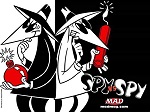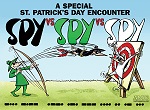Secret Communications
|
|
Original Spy vs Spy (Mad magazine) Spy vs Spy vs Spy (Mad magazine). The Morse code says "By Prohias" In this 1946 issue of Radio-Craft magazine, editor and über electronics guru Hugo Gernsback reviews "Secret Communications" methods used throughout history, including Alexander Graham Bell's "Photophone" that used a modulated light beam for transmission. With World War II having recently ended and devices such as the "Enigma Machine" developed by the Germans for secure encryption of messages, secure communications was high on the priority list of government and military strategists. Gernsback also suggests ultrasonic systems for wireless communications, and a multiple channel scheme suggestive of the m−ary method widely used today. Secret Communications -There are many media suitable for communications By Hugo Gernsback The art of secret, or private communication is as ancient as the human race. Ever since the dawn of civilization men have tried to perfect ways and means of communicating with each other privately or secretly - be it during peace time or in war. During the past 100 years science has enabled the communications field to expand enormously, and new means of communication have been invented in profusion. The advent of electricity, and particularly the telegraph and telephone, have made strictly private and often secret communication easier. Thus, during war, even in the earlier days of the telephone and telegraph, special means were developed to make communication over these media as secret as possible in order that an enemy could not decipher the message. Special machines for coding purposes were invented, but few have proven to be "unbreakable." Later on, when radio expanded, new means were found for private communication, but here also secrecy was only partial. During peace time, for instance, when you telephone an overseas friend by the present radio transmission system, the ordinary person who has a short wave radio set cannot listen in on your conversation because the talk is split over two separate channels. Unless the listener has the combination and the special radio hook-up to combine the two messages into one, he hears only gibberish, which he cannot make out. This gives partial secrecy. Yet a radio engineer might hook up a special radio receiver to listen into anyone's Trans-Atlantic or overseas communication should he so choose. The secrecy, therefore, is not complete. There are, of course, code machines and other means by which the secrecy can be almost perfect, but during the war it was found that no system could remain secret for long. All codes were eventually "broken." This spurred on the technicians of all the warring nations as well as others to find some media which would be mote secret than wire or radio. The Germans possibly were the first to grab the ancient Alexander Graham Bell Photophone whereby one talks over a light ray without any intervening wires. The Bell Photophone was invented in 1880, and has often proven not only an interesting stunt for experimenters to converse with each other over a light ray for miles, but had also a number of commercial applications in the past. When radio amplifiers came into vogue the instrument could be perfected and made more sensitive by modern instrumentalities. Soon the Germans were using it in their so-called "Lichtsprecher" (lightspeaker) during World War II. This is merely a refinement of the Bell Photophone. With this instrument troops and command posts could talk over a light ray for many miles. The secrecy here was nearly perfect. Such a conversation could not be "tapped" easily between two points as long as the listener was not in a direct line between the points between which communication was carried on. Between two points, inaccessible to the enemy, it is therefore, possible to converse without much danger. It is possible to use ordinary sunlight as well as any other strong light source. The light beam is then modulated and communication established. There are many other ways to communicate in a similar manner without using visible light rays. The Germans also early perfected a system whereby infra-red waves were used and this system also was fairly secure, particularly during night-time. When one speaks over a visible light beam at night the position is apt to be given away to the enemy, and if he is within gun range he will try to destroy the source of the light, because he knows it is being used for communication. Not so with infra-red waves which are difficult to spot and difficult to locate, and, therefore, relatively safe. So far; however, infra-red communication has not been satisfactory over greater distances than about ten miles. It is certain, however, that it will be improved in time; only the horizon will then limit the range of communication. There are yet other means at our disposal as, for instance, ultra-violet ray communication. Very little about this has appeared in print and there are certain difficulties connected with it, but in due time ultra-violet radiation will also be used for secret communication. Science does not stop here. We give a few more examples, which so far have not been described - to the best of our knowledge - Human ears can only hear up to a certain point of the sound scale, thus any vibration beyond 15,000 cycles becomes inaudible to us. That is, for human beings, not for animals. Thus dogs and particularly canary birds, can hear much further up in the sound spectrum than human beings. There is now manufactured a special dog whistle, which only dogs can hear. You blow it, but hear nothing whatsoever as the sound waves generated by this whistle are beyond human reach. The dog, however, hears it very well over quite a distance. Scientists a few years back found the reason why bats can fly in a dark room criss-crossed with wires yet never once fly into the wires or collide with the walls. The reason is that bats generate supersonic sounds in their throats so high that human beings cannot hear them, yet when the bat makes these sounds they are reflected from whatever objects are in its path and return to its ears. A sort of audible radar. Consequently, a bat never collides with any solid object. The scientists who investigated the bat's sounds had to translate these sounds into audible sounds for human beings, which they did by means of electronic apparatus. Now then, it seems a short step from this to generate inaudible sounds in a simple apparatus, then modulate the sound the same as we do with a radio wave and use it as a carrier either for voice or for code. At the receiving end these supersonic sounds are made audible to the human ear by means of special amplifiers, and communication is accomplished. Such a system would seem to have possibilities for secret communication for war as well as peace purposes, and no doubt many applications can and will be found for it. Furthermore, as sound can be focused by parabolic reflectors, the same as light rays or infra-red rays, the system becomes more or less secret if no one is in the direct line of the transmission. Supersonics thus may open up a new system for communication. To the best of our knowledge little communication has been carried on by this method. We wish to advance some additional thoughts along these lines for still greater secrecy and safety from detection. We can adopt the principle of splitting communication. Nothing prevents us from doing this, using any combination of the means described above. We can thus use a separate light ray transmitter and a separate infra-red transmitter, either side by side (or separated a suitable distance) and then send out our communication over both these channels, splitting up the communication. Then if anyone attempts to intercept the light ray itself, only gibberish results. If he succeeds in tapping the secret infra-red channel, likewise nothing intelligible can be heard. Unless you have the "key" and know what is going on and know what types of channels and media are used, you are not likely to guess the secret at once. Not only that, but you also have to know the exact location, all of which puts additional handicaps in the way of the unauthorized listener. At the receiving end of the key receiver the light-ray transmission and the infra-red ray transmission are combined and the speech (or code) is resolved into intelligible communication. We need not stop here, but we can "scramble" our channels in many ways. Thus we can have infra-red plus supersonic sound. We can have radio plus infra-red, or we can have light plus radio. Thus we obtain dozens of different combinations, enhancing the secrecy many fold. In time, particularly during war and for war purposes, there is no reason why only two channels of different media should be used. One can send out split communications over six or more different channels, and only by combining all these channels would you have a complete intelligible communication. A fascinating new field in communication, which so far has not been exploited at all, is thus opened.
Posted October 20, 2021 |
|


